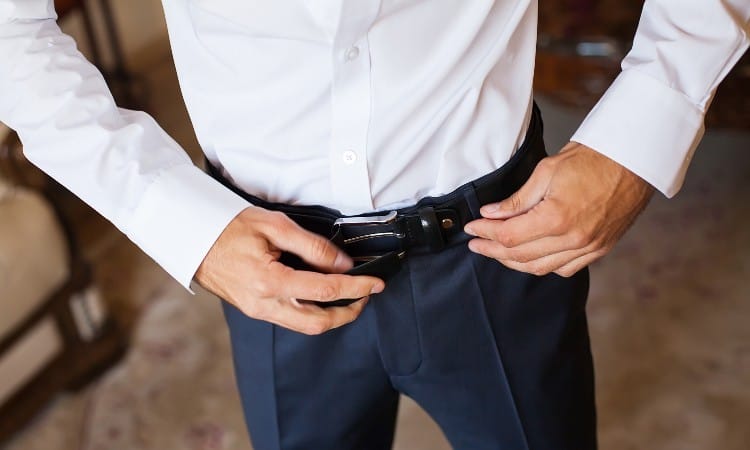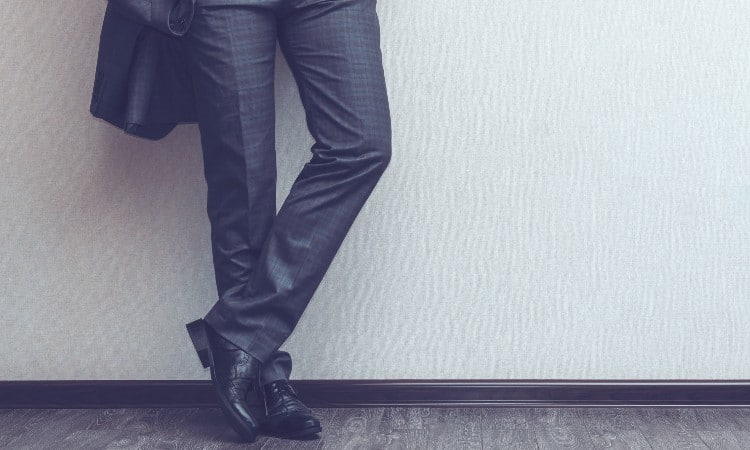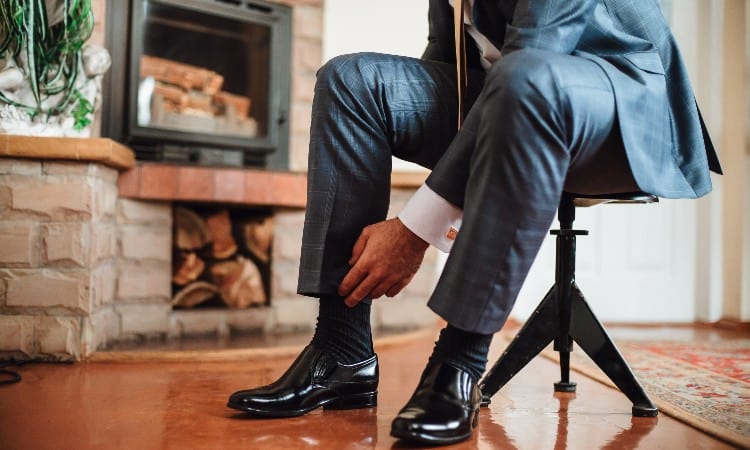There is nothing quite like wearing a perfectly fitting suit. A well-tailored suit can make everyone look sophisticated and stylish, no matter the occasion. However, a suit that doesn’t fit well is immediately noticeable and can make you look sloppy.
When it comes to suit pants, there are several different ways to determine the correct fit. To begin, you’ll need to decide which fit of dress pants you prefer, ranging from the looser fit of a classic style to more modern and slim-fitting options. Then, you’ll need to check to make sure the pants fit you at six key points – the waist, rise, hips/seat, length, leg width, and overall leg shape.
This article is here to help you answer the ultimate question – how should suit pants fit? Keep reading as we break down the different fits for dress pants you can choose from and how those pants should fit at each part of your body from waist to ankle. In no time at all, you’ll be picking out the perfect pair of suit pants for your next formal occasion.

What Are The Different Fits For Dress Pants?
When choosing the right fit for your dress pants, you need to start by deciding what overall style and look you are going for. It used to be the case that suit pants were only worn in a classic, looser-fitting style. However, suit styles throughout history have changed frequently and today’s modern suits are cut in many different fits, many of which are slim and form-fitting.
Classic Fit
If you’re looking for a timeless style of dress pants that you can wear for years, classic-fit dress pants may be a perfect choice. Classic-fit dress pants are the most traditional style worn today. They fit comfortably and fall right at your natural waistline but aren’t known to be particularly slim fitting or tailored close to your curves.
In fact, there is no tapering at all through the legs of classic-fitting pants. This gives classic-fit dress pants an overall wider, straight leg and a larger opening where the pants meet your shoes.
Classic-fit pants are generally recommended for people who wear suits in formal settings or traditional workplaces. They are also recommended for people who are on the taller side or are heavier set. For people who fit these descriptions, the looser fit helps to create an overall better silhouette and a more streamlined look.
Modern Fit
Suit pants come in many different styles, from the loose cut of classic-fit pants to very tapered, slim-fitting options. Within this broad range, modern-fit suit pants fall somewhere in the middle. As the name implies, this style of pants is more modern than some styles but doesn’t quite hug the body as closely as slim-fit options do.
The slightly roomier legs of modern-fit dress pants are great for people of average height and build. They will fit well and be comfortable without being too snug. All-in-all, modern-fit dress pants are one of the best and most versatile options on the market today.
Slim Fit
Slim-fitting dress pants are one of the more modern takes on classic suit pants. Instead of having wide, straight legs, slim-fitting pants are tapered to hug the curves of your calves much more closely. The opening around your ankles is much smaller, and there is generally much less fabric that pools on top of your shoes.
Slimmer-fitting suit pants are perfect for people who work in more relaxed environments. They are an excellent choice for people who are average in height and who are a bit on the slender side. Tapered pants are generally not recommended for people who are heavier set since they can draw attention to all of the wrong places and make your legs look larger.
Fitted
You may come across suit pants labeled as “fitted” dress pants. “Fitted” suit pants are just another name for the many slim-fitting styles on the market. These pants will likely come pre-fitted to fit slimmer body shapes, but some suit wearers will take their pants to a tailor to achieve the perfect fitted look.
How Should Suit Pants Fit? 6 Key Points

Regardless of which overall style of dress pants you choose, it is important that your pants fit you correctly. There are six key areas to pay attention to when judging the fit of your pants. These include how they fit at your waist, the overall rise, hips/seat, length of the pants, leg width, and leg shape.
Waist
Determining whether or not your pants fit at the waist is pretty straightforward. Regardless of the style of suit pants you prefer, the pants should sit snugly at your waist without being too tight or too loose. You shouldn’t feel like the pants are digging into your waistline, but you also shouldn’t have to use a belt to cinch the pants up dramatically.
If your pants are too tight, it will be very apparent and difficult to tuck in your shirt. On the other hand, if your waistband is too loose, your pants may constantly be falling or you’ll have to use a belt which may create awkward bunching around your waist. While many other areas of your pants can be tailored to fit, waistbands are sometimes difficult to modify, so you should always check this measurement first when buying new suit pants.
Rise
The rise on pants is a measurement that is calculated by measuring the fabric that goes from the front hem of your pants, between your legs, to the back hem. In more traditional, classic-fit styles, the rise should be long enough that the waist of your dress pants falls at your natural waistline. In other words, for classic-fit pants, the rise should be long enough that the waistband falls at the midpoint to the upper part of your hip.
If you are a fan of slimmer-fitting or more modern styles, the rise can be shorter and the waistband can sit a bit lower. However, if the rise is too short on your pants, you might feel them riding up and pulling too tight around your groin. On the opposite end of the spectrum, if the rise of your jeans is too long, the waistband of your pants will fall far too high – up to your belly button or higher.
Hips/Seat
The seat of your pants is the part that makes contact with a chair whenever you sit down. In other words, it is the back area of your pants stretching from one side of your hips to the other. It is important that you pay attention to this area to make sure that the seat of your pants is not too tight or too loose.
If the seat of your pants is too tight, they will cling to your butt very closely and may not be appropriate for the workplace. They’ll also pull tight when you sit or bend over, which could eventually cause your pants to rip. On the other hand, if the seat of your pants is too loose, they will look baggy and immediately show that your pants do not fit right.
The seat is probably a bit too snug if your pants feel tight when you sit or bend over. If you have trouble sticking your hands in your pockets, this can be another sign that the seat is too tight. On the other hand, if you put your hands in your pockets and can pull the pants away from your hips by more than an inch or two, the seat may be too loose.
Length

Length is a measurement that can be tricky to figure out since it depends entirely on the style of pants you are going for. One of the key things to understand with length is the different styles of pant breaks that your suit can have. Each style of pant break needs to fall at a different point on your leg while wearing dress shoes.
Full-break pants are the most traditional length of suit pants you will find. This style is most commonly seen on classic-fitting dress pants and is long enough that a large amount of fabric will be pooled on the tops of your shoes while wearing the pants. This style is best suited to wider-legged suit pants, and you’ll know the length is correct if the pants fall to the halfway point on the back of your dress shoes while wearing them.
Half-break pants don’t have as much length as full-break options, but they are still more of a classic fit. This style of pants should be long enough to fall below your ankles but not as far down as full-break pants will. This pants style should also be a bit narrower at the bottom than full-break options, which further helps prevent them from covering as much of your shoe as the previous style does.
Quarter-break pants are one of the more modern options you can choose. You know that this style of pants is the correct length if there is almost no fold when the bottom of the legs hits your shoes. Your socks and the very top of your shoes should still be covered, but the pants should not fall down the back of your shoes much at all.
Cropped or no-break pants are the shortest style you can choose and are mostly available as slim-fitting cuts. Cropped pants are the right length if they end above your shoes and show a small portion of your socks. They should not fold at the bottom of your shoes or extend down the back of them when you stand.
Leg Width
When it comes to leg width, the nice thing about figuring out the best fit is that it is entirely up to your own preference. If you prefer your pant legs to be straight and a bit wider, you can opt for a classic fit that does just that. If you would rather have pant legs that are more form-fitting and tapered, that is also an option.
The goal is that your pant legs should not be overly baggy or too slim-fitting. If you want wider legs, you should be able to pull them away from your leg by an inch or two. If you want slimmer-fitting suit pants, you should be able to see your shape without having the pants cling so tightly to you that they pull in strange ways as you walk or sit.
Leg Shape
Much like leg width, the overall shape is also up to your preference. Generally, if you prefer a classic fit, you want the shape of the legs to be fairly straight and not tapered. The openings at the bottom should be fairly large.
However, if you prefer a slimmer fit, you want the opposite. The legs should not be straight down to your ankles and should instead taper to fit the curve of your legs. The openings at the bottom should be narrower in shape.
Where Are Suit Pants Supposed To Fall?

Where suit pants should fall on your legs depends on your style preference. If you prefer a classic fit that is a bit more traditional, you want a full break on your pants. In other words, they should fall far enough to pool on the top of your dress shoes and should extend halfway down the back of your heel.
However, many modern styles have departed from this traditional look. If you prefer a slimmer fit of pants, you can choose cropped or no-break pants. These pants should fall above your shoes, showing off a small amount of your socks. They should not pool or gather on the tops of your shoes they shouldn’t touch them much, if at all.
Because suit styles vary so widely, there’s no single answer as to where suit pants should exactly fall. It mostly depends on what your personal style preferences are and what overall look you are going for.
How Do You Know If Suit Pants Are Too Big?
There are several ways to spot suit pants that are too big. Starting at the waist, your suit pants are too large if you require a belt or suspenders at all times to keep them up. A belt can be useful to give a bit of extra hold, but it shouldn’t cause the fabric to bunch up around your waist. This is a clear sign the pants are too big.
You can also look at the fit around your legs. Even if you prefer a classic fit that is a bit looser around your thighs, you shouldn’t be able to pull the fabric more than an inch or two away from your leg. If you can, that is a clear sign that the legs of your pants are the too big and a smaller size of pants is needed.
Additionally, you can tell if suit pants are too big if they fall too low on your legs. Classic-fit pants are the longest style, and even these shouldn’t fall more than halfway down the backs of your shoes. If too much fabric is on your feet, it is a clear sign that the pants are too long.
Don’t forget to also keep personal preference in mind. If you put on the suit pants and feel like they are just too roomy to wear, that is often all you need to decide the pants are too big to wear. They should be comfortable but should also still look like they were tailored to fit your frame.
How Tight Should Suit Pants Be?
To some extent, the tightness of your suit pants is up to your own personal style preference. If you like your pant legs to be a bit looser, you can choose a pair with plenty of room around the thighs. On the other hand, modern suits are often tailored to be slim-fitting if that is also your preference.
There are a few things to be on the watch for, however. Your pants should be tight enough that they fit at the waist without requiring a belt to bunch them up. They shouldn’t be so baggy that there is many inches’ worth of extra fabric around your thighs.
On the other hand, you should be able to bend over and sit down without feeling like your suit pants are pulled too tight. They shouldn’t cling to your butt or hips very much, even if you prefer a slim-fitting style. In other words, they should be tight enough to look like they were made custom for your body but shouldn’t be so tight that they are uncomfortable.
Should Suit Pants Be Tight?

In general, suit pants should fit you well but should not be overly tight. Exactly how tight-fitting they depend on the style you prefer and how you want them to fit.
At the Waist
Suit pants should be snug enough at the waist to stay up but should not be so tight that they dig into your stomach. On the other hand, you don’t want them to be so loose that you have to use a belt to bunch up the fabric.
When Sitting
When you sit down in suit pants, you should expect the fabric to tighten up a bit as it stretches across your hips. However, the pants should not be so tight and uncomfortable while sitting. You should still be able to cross your legs comfortably while sitting in suit pants.
On Thighs
The thigh area is one place where the tightness of your pants will vary according to your style preferences. Classic-fit pants should not be tight in the thighs and should be able to pull away from your legs by an inch or two. Slimmer style suit pants should be a bit more form-fitting around your thighs but shouldn’t cling so tightly that you cannot pull the fabric away from your legs a small amount.
Do Suit Pants Stretch?
Generally, suit pants are not particularly stretchy. They will have some give to them, but on the whole, they are meant to be fairly stiff and keep their shape while you wear them. It’s one of the reasons why many office settings prefer them – they’ll keep you looking professional all day long.
Because of this, it is important that you buy pants that fit you properly. The chances of them stretching to fit you later are pretty low. If you have to buy larger suit pants, you should be prepared to have them tailored by a professional tailor.
Conclusion
By this point, you should now be prepared to find the perfect pair of suit pants and can judge whether or not they fit you the way they should. Keep in mind the tips we have shared here as you select the new additions to your wardrobe. If you do, you’re sure to make a great impression no matter where you wear your suit pants.